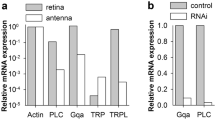Abstract
HETEROTRIMERIC G proteins couple various receptors to intracellu-lar effector molecules. Although the role of the Gα subunit in effector activation, guanine nucleotide exchange and GTP hydro-lysis has been well studied1–4, the cellular functions of the Gα subunits are less well understood5,6. Gβγ dimers bind Gα subunits and anchor them to the membrane for presentation to the receptor7–9. In specific systems, the Gβ subunits have also been implicated in direct coupling to ion channels and to effector molecules10–19. We have isolated Drosophila melanogaster mutants defective in an eye-specific G-protein β-subunit (Gβe), and show here that the β-subunit is essential for G-protein-receptor coupling in vivo. Remarkably, Gβ mutants are also severely defective in the deactivation of the light response, demonstrating an essential role for the Gβ subunit in terminating the active state of this signalling cascade.
Similar content being viewed by others
References
Ross, E. M. Neuron 3, 141–152 (1989).
Bourne, H. R., Sanders, D. A. & McCormick, F. Nature 349, 117–127 (1991).
Simon, M. S., Strathmann, M. P. & Gautam, N. Science 252, 802–808 (1991).
Conklin, B. R. & Bourne, H. R. Cell 73, 631–641 (1993).
Iniguez-Lluhi, J., Kleuss, C. & Gilman, A. Trends Cell Biol. 3, 230–236 (1993).
Clapham, D. & Neer, E. Nature 365, 403–406 (1993).
Fung, B. K.-K. J. biol. Chem. 258, 10495–10502 (1983).
Florio, V. A. & Sternweis, P. C. J. biol. Chem. 264, 3909–3915 (1989).
Sternweis, P. C. J. biol. Chem. 261, 631–637 (1986).
Logothetis, D. E. et al. Nature 325, 321–326 (1987).
Federman, A. D., Conklin, B. R., Schrader, K. A., Reed, R. R. & Bourne, H. R. Nature 356, 159–161 (1992).
Tang, W.-J. & Gilman, A. G. Science 254, 1500–1503 (1991).
Blank, J. L., Brattain, K. A. & Exton, J. H. J. biol. Chem. 267, 23069–23075 (1992).
Boyer, J. L., Waldo, G. L. & Harden, T. K. J. biol. Chem. 267, 25451–25456 (1992).
Camps, M. et al. Nature 360, 684–686 (1992).
Katz, A., Wu, D. & Simon, M. I. Nature 380, 686–689 (1992).
Kurjan, J. A. Rev. Biochem. 61, 1097–1129 (1992).
Blumer, K. J. & Thorner, J. Proc. natn. Acad. Sci. U.S.A. 87, 4363–4367 (1990).
Lilly, P., Wu, L., Welker, D. L. & Devreotes, P. N. Genes Dev. 7, 986–995 (1993).
Dolph, P. J. et al. Science 260, 1910–1916 (1993).
Yarfitz, S., Niemi, G., McConnell, J., Fitch, C. & Hurley, J. Neuron 7, 429–438 (1991).
Ranganathan, R., Harris, G. L., Stevens, C. F. & Zuker, C. S. Nature 354, 230–232 (1991).
Hardie, R. Proc. R. Soc. Lond. B245, 203–210 (1991).
Smith, D. P. et al. Science 254, 1478–1484 (1991).
Ranganathan, R., Harris, W. & Zuker, C. S. Trends Neurosci. 14, 486–493 (1991).
Zuker, C. S. Curr. Opin. Neurobiol. 2, 622–627 (1992).
Lee, Y. J., Dobbs, M. B., Verardi, M. L. & Hyde, D. R. Neuron 5, 889–898 (1990).
Minke, B. in The Molecular Mechanisms of Phototransduction (ed. Steive, H.) 241–286 (Springer, New York, 1986).
Yamazaki, A. et al. J. biol. Chem. 265, 11539–11548 (1990).
Pitcher, J. et al. Science 257, 1264–1267 (1992).
Ron, D. et al. Proc. natn. Acad. Sci. U.S.A. 91, 839–843 (1994).
Yarfitz, S., Provost, N. M. & Hurley, J. B. Proc. natn. Acad. Sci. U.S.A. 85, 7134–7138 (1988).
Hardie, R. C. et al. Nature 363, 634–637 (1993).
Author information
Authors and Affiliations
Rights and permissions
About this article
Cite this article
Dolph, P., Man-Son-Hing, H., Yarfitzt, S. et al. An eye-specific Gβ subunit essential for termination of the phototransduction cascade. Nature 370, 59–61 (1994). https://doi.org/10.1038/370059a0
Issue Date:
DOI: https://doi.org/10.1038/370059a0
- Springer Nature Limited
This article is cited by
-
Dietary restriction and the transcription factor clock delay eye aging to extend lifespan in Drosophila Melanogaster
Nature Communications (2022)
-
Phototransduction in Drosophila
Science China Life Sciences (2012)
-
Phototransduction and retinal degeneration in Drosophila
Pflügers Archiv - European Journal of Physiology (2007)
-
Current issues in invertebrate phototransduction
Molecular Neurobiology (1997)





